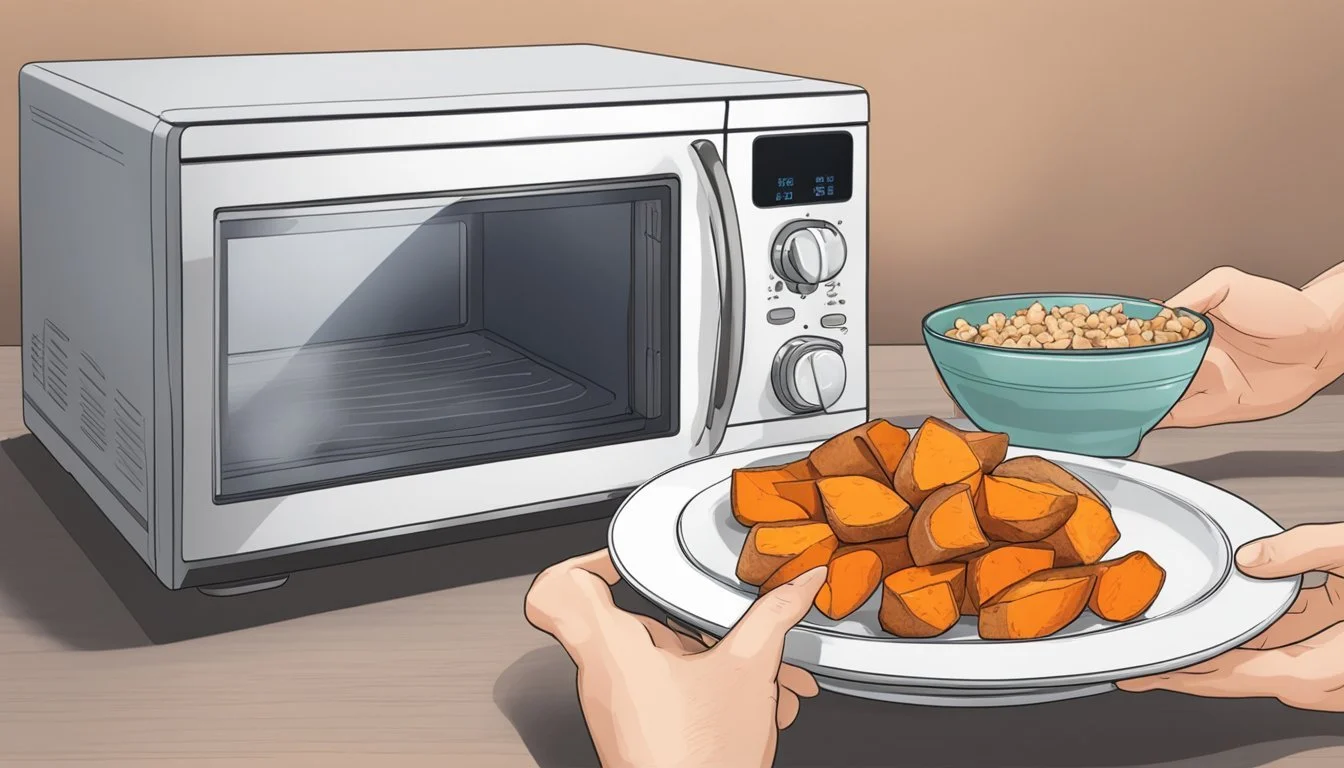How to Reheat Gluten-Free Roasted Sweet Potatoes
Best Methods Explained
Reheating gluten-free roasted sweet potatoes can be done effortlessly while retaining their delicious flavor and texture. To reheat your roasted sweet potatoes, preheat your oven to 350°F, place the sweet potatoes on a baking sheet, and reheat for 10-15 minutes. This method ensures that the exterior remains crispy and the interior stays warm and tender.
Another effective way to reheat roasted sweet potatoes involves using a skillet. By placing the sweet potatoes in a skillet over medium heat, covering with a lid, and occasionally stirring, you can achieve a well-warmed dish without losing the coveted crispiness. Sprinkling a bit of olive oil before reheating can further enhance the flavor and texture.
For those who appreciate a touch of spice, adding cinnamon or nutmeg during reheating can elevate the humble sweet potato into a savory delight. Remember, maintaining their gluten-free integrity is simple when just reheating without adding any gluten-containing ingredients.
Understanding Sweet Potatoes
Sweet potatoes are versatile tuberous vegetables known for their rich nutritional profile and multiple culinary uses.
Nutritional Profile
Sweet potatoes are packed with nutrients that contribute to a healthy diet. A medium-sized sweet potato contains approximately 103 calories.
They are rich in carbohydrates, providing energy, and have a good amount of fiber, which aids digestion. Each sweet potato also contains about 2 grams of protein.
In terms of vitamins, sweet potatoes are a powerhouse, especially for Vitamin A. They also offer Vitamin C, Vitamin B6, and potassium. These nutrients support immune function, skin health, and overall well-being.
Selection and Storage
When selecting sweet potatoes at the grocery store, look for those with smooth skin and a firm texture. Avoid any with visible bruises or cuts.
After purchasing, store sweet potatoes in a cool, dark place like a pantry. They should be kept at room temperature and not in the fridge, as this can affect their taste and texture.
For longer storage, sweet potatoes can be kept in the freezer. First, peel and cut them into cubes, then place them in an airtight container. They can last several months this way without losing their nutritional value.
Preparations Before Reheating
To ensure reheating gluten-free roasted sweet potatoes results in optimal flavor and texture, it's essential to properly handle leftovers and choose the right oils. These steps will help preserve the quality and enhance the taste of the reheated dish.
Handling Leftovers
Proper handling of leftovers is crucial for maintaining the quality of roasted sweet potatoes. After roasting, allow them to cool to room temperature. It's important to store them in an airtight container to maintain freshness and prevent unwanted flavors from seeping in. Refrigerate the sweet potatoes within two hours of roasting to avoid bacteria growth.
If the sweet potatoes still have their skin, leaving it on can help preserve moisture during storage. When ready to reheat, ensure the sweet potatoes are free from any debris or excess moisture, which can compromise texture.
Choosing the Right Oil
Selecting the right oil can make a significant difference in the reheating process. Olive oil is a popular choice due to its mild flavor and health benefits. For a richer taste, avocado oil or coconut oil can be used. Coconut oil adds a subtle sweetness that pairs well with sweet potatoes.
A light spritz of oil before reheating can help maintain a crispy exterior. Avoid using excessive amounts of oil, as it can make the potatoes greasy. Preheating the oven before placing the sweet potatoes in can also help achieve the desired texture.
Reheating Techniques
Reheating gluten-free roasted sweet potatoes can be done effectively using a variety of methods depending on the texture and convenience you desire. Below are detailed instructions for the oven, microwave, pan, and air fryer methods.
Oven Method
Using the oven to reheat sweet potatoes is ideal for maintaining a crispy exterior and fluffy interior. Preheat the oven to 350°F (175°C). Place the sweet potatoes on a baking sheet lined with parchment paper or foil. Spritz them lightly with olive oil to help keep the crispiness. Heat for 10-15 minutes or until warmed through. For more evenly distributed warmth, consider turning the potatoes halfway through reheating. This method works well for whole, halved, or sweet potato cubes.
Microwave Method
For a quick and easy reheating solution, the microwave is your best bet. Place sweet potatoes on a microwave-safe dish. Cover them with a microwave-safe lid or a piece of parchment paper to retain moisture. Heat on high power for 2-3 minutes. Check and stir halfway to ensure even heating. While this method is convenient, it might result in a softer texture, which is fine for smaller portions or a quick snack but may not preserve the original crispy exterior.
Pan Method
The pan method is great for achieving a slightly crispy texture without using an oven. Heat a non-stick pan over medium heat. Add a small amount of olive oil or butter. Place the sweet potatoes in the pan, cooking and turning occasionally for 5-7 minutes. Use a lid for the first few minutes to trap heat and ensure they are warmed through. This is particularly effective for sweet potato cubes or smaller pieces.
Air Fryer Method
For the best crispy results, the air fryer can be employed. Preheat the air fryer to 350°F (175°C). Arrange the sweet potatoes in a single layer in the air fryer basket, ensuring they are not overcrowded. Reheat for 5-6 minutes, shaking the basket halfway through to ensure even cooking. This method retains the crispy roasted texture while heating the inside perfectly. Works excellent for both whole and cubed sweet potatoes.
Seasoning and Flavor Enhancement
Enhancing the flavor of gluten-free roasted sweet potatoes can significantly elevate the dish. Various herbs, spices, and condiments can be used for a perfect balance of sweetness and savoriness.
Herbs and Spices
Herbs like rosemary and thyme add a fresh, earthy taste to roasted sweet potatoes. A sprinkle of Italian seasoning or a dash of garlic powder and onion powder can also boost the flavor profile.
Black pepper and paprika introduce a mild heat, while cumin and chili powder give a more robust, smoky edge. Combining these spices in varying proportions allows for a customizable seasoning blend that complements the natural sweetness of the potatoes.
Sweet and Savory Combinations
Balancing sweet and savory elements is essential for a standout dish. Brown sugar or maple syrup can be mixed with butter to glaze the sweet potatoes before reheating, creating a caramelized layer that enhances their natural sweetness.
For a sweet yet tangy note, adding a touch of honey pairs well with a hint of black pepper or garlic powder. This combination introduces a delightful contrast that keeps the palate interested.
Creative Condiments and Toppings
Incorporating creative condiments and toppings can transform reheated roasted sweet potatoes. A light drizzle of maple syrup or a scattering of marshmallows can add a delightful twist.
For more savory options, try a blend of garlic sautéed in butter or a sprinkle of chili powder on top. These toppings add layers of flavor and texture, making the dish more complex and enjoyable.
Serving Suggestions
Reheated gluten-free roasted sweet potatoes can be enjoyed in a variety of ways. They serve as an excellent side dish, integrate seamlessly into main courses, and pair well with numerous complementary ingredients.
As a Side Dish
Reheated roasted sweet potatoes are a versatile side dish that can be served alongside many meats and vegetarian options. Complement a baked chicken dinner, or pair with grilled fish for a nutritious and flavorful meal.
For a traditional touch, serve them at Thanksgiving alongside turkey. Add a drizzle of maple syrup or a sprinkle of cinnamon to enhance their natural sweetness. Sweet potatoes can also be topped with herbs and spices to add depth to their flavor profile.
Integrating into Main Courses
Roasted sweet potatoes can easily be incorporated into a variety of main courses. Add them to chicken casseroles, where their natural sweetness balances savory elements. Mixed into breakfast hash with black beans and eggs, they provide a hearty start to the day.
For a vegetarian option, combine them with quinoa or wild rice in a warm salad. Sweet potato recipes are highly adaptable and can fit into many cuisines. Turn them into a base for a spicy curry or mix into a burrito bowl for a hearty meal.
Complementary Pairings
When it comes to complementary pairings, roasted sweet potatoes shine. Mix them with black beans for a protein-rich vegetarian dish. They also pair well with fresh salads, adding both texture and flavor. Consider combining them with a kale or spinach salad, garnished with cranberries and a light vinaigrette.
For a breakfast twist, pair sweet potatoes with scrambled eggs or as a topping for avocado toast. Their natural sweetness also complements savory ingredients such as feta cheese or bacon, creating a balanced dish.
Post-Preparation Tips
Reheating gluten-free roasted sweet potatoes can be simple if proper steps are taken to store leftovers and maintain the dish's quality and safety. Following these tips will ensure your sweet potato dish remains delicious and safe to eat.
Storage After Reheating
To store leftovers, place the reheated sweet potatoes in an airtight container. Store in the fridge for up to 3-4 days. This helps preserve the texture and flavor.
If you prefer to freeze them, let them cool completely before transferring to a freezer-safe container. Label the container with the date and recipe details. They can be frozen for up to 2 months.
Avoid stacking the sweet potatoes to prevent sticking. For best results, freeze in a single layer on a baking sheet before transferring to a container.
Maintaining Quality and Safety
To ensure the best quality, reheat leftovers using an oven or a microwave. For the oven, preheat to 350°F and bake for 10-15 minutes. This helps retain a firm exterior. In the microwave, reheat in a microwave-safe bowl, covered, for 2-3 minutes.
Monitor the cook time to avoid overcooking. Spritz with olive oil before reheating to maintain moisture.
Follow proper food safety practices by ensuring leftovers reach an internal temperature of 165°F. This prevents any foodborne illnesses. Use a food thermometer to check if necessary.
By following these steps, you can enjoy your reheated gluten-free roasted sweet potatoes safely and with great taste.
Advancing Your Sweet Potato Experience
Enhancing the flavors and textures of gluten-free roasted sweet potatoes can elevate their taste. This section explores variations and advanced techniques to ensure your sweet potato dishes are always delightful.
Exploring Variations
1. Spicing Up the Flavor: Adding spices like cinnamon or nutmeg during reheating can bring warmth to your roasted sweet potatoes. A pinch of cumin or smoked paprika can introduce a savory depth.
2. Experimenting with Sweet Potato Fries: Cut sweet potatoes into fries, season them with salt, pepper, and olive oil, and bake at 425°F until crispy. This recipe offers a healthier alternative to regular fries.
3. Trying Vegan Recipes: Vegan toppings, such as tahini or avocado hummus, can enhance roasted sweet potatoes without compromising dietary restrictions. These toppings provide creamy textures and additional nutrients.
4. Incorporating Herbs: Scatter fresh herbs like rosemary or thyme over the sweet potatoes before reheating. This simple addition can transform their flavor profile.
Learning More Advanced Techniques
1. Achieving Crispy Perfection: To keep roasted sweet potatoes crispy, spread them in a single layer on a sheet pan and spritz with olive oil before reheating. This method helps maintain their desired texture.
2. Mastering Mashed Sweet Potatoes: For mashed sweet potatoes, reheat gently on the stove with a splash of almond milk to maintain creaminess. Stir frequently to avoid sticking.
3. Utilizing the Skillet: Reheating sweet potato cubes in a skillet with a touch of oil can help retain their crispiness. Stir occasionally to ensure even heating.
4. Enhancing with Broiling: Finish reheating by broiling the sweet potatoes for a couple of minutes. This step can give them an appealing crispy surface that is both visually and texturally satisfying.
By following these variations and advanced techniques, you can enhance the dining experience and make the most out of your gluten-free roasted sweet potatoes.
Connecting with the Community
Engaging with the community can provide valuable insights and foster a sense of belonging. Whether it's sharing your sweet potato recipe on social media or seeking feedback from fellow cooks, connecting with others can enhance your culinary experience.
Sharing on Social Media
Sharing your gluten-free roasted sweet potato recipe on social media platforms like Instagram, Facebook, and Pinterest can create a vibrant dialogue around your cooking skills.
On Instagram, use high-quality photos and engaging captions. Utilize relevant hashtags like #glutenfree, #sweetpotatorecipe, and #healthyfood to reach a wider audience. You could even create short video clips demonstrating key steps of your recipe.
Facebook groups dedicated to gluten-free cooking are also a great space to share your recipe. Engage by commenting on other posts and responding to feedback.
On Pinterest, create visually appealing pins that link directly back to your recipe. Adding keyword-rich descriptions can boost the visibility of your pins, helping more people discover your culinary creations.
Seeking Feedback
Requesting feedback from your community can be incredibly informative. After sharing your sweet potato recipe online, encourage followers to provide reviews and ratings. This can be as simple as asking a question at the end of your post.
Create a poll or feedback form on Facebook or Instagram Stories to gather specific insights. Questions like, "Did you find the seasoning to be well-balanced?" or "Would you make any changes to this recipe?" can prompt detailed responses.
Check reviews and comments regularly to understand what aspects of your recipe are most appreciated or need improvement. Pay attention to common suggestions and incorporate those changes to refine your recipe. By actively seeking and valuing feedback, you can continuously enhance your roasted sweet potato dish.










